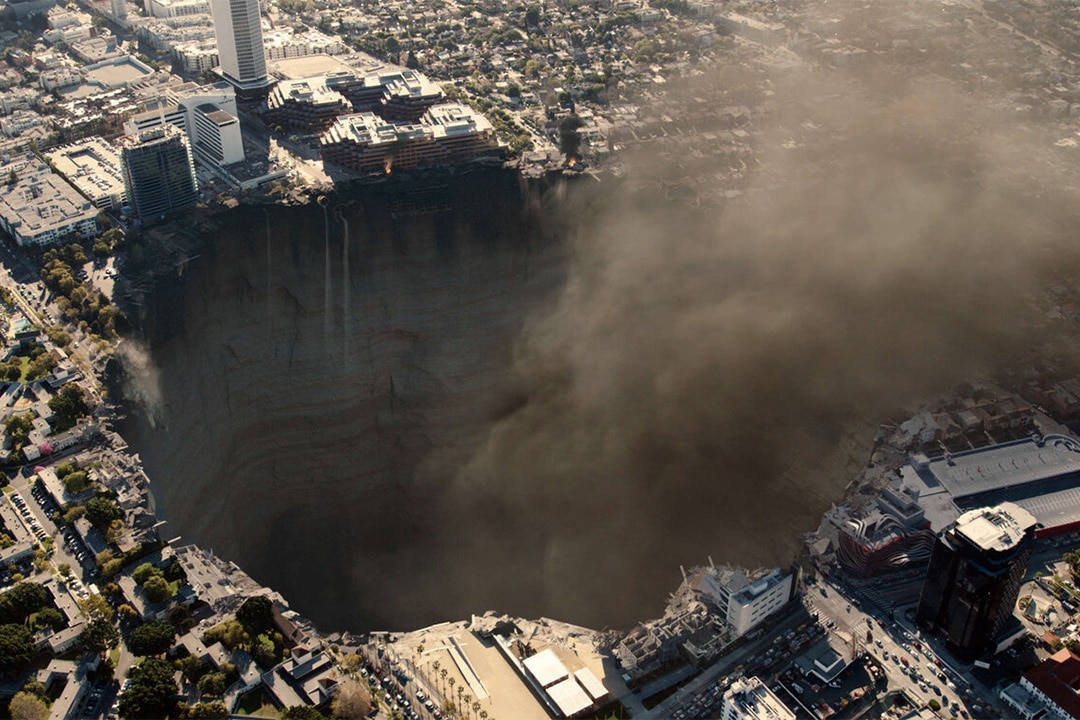Swallowed by sinkholes: The science behind 'La Brea'

The La Brea tar pits have long been a fascinating window into another world. Underground petroleum deposits rise to the surface where the lighter components evaporate away. What's left is a black and sticky substance commonly called tar, but more accurately called asphalt. Countless plants and animals have found themselves trapped in the pits, where their bones sink and are preserved. The pit's inky black surface serves as a sort of dark portal to the past.
La Brea, a new adventure series airing on Tuesdays on NBC, takes this notion a step further. When a massive sinkhole opens up at the site of the pits; cars, buildings, and hundreds of people fall into its depths, seemingly to their death. Instead, they find themselves in another world and must work together to survive and, hopefully, find their way home.
The idea of a hollow Earth, one which houses a secondary biosphere, dates back centuries. It was notably suggested by Edmond Halley (yes, that Edmond Halley of comet fame) in the late 17th century as a way of explaining some of his observations.
A number of expeditions have been undertaken in hopes of finding an entrance to such an underground world, all of which have, as yet, been unsuccessful. We can probably collectively agree that there is no lost world filled with incredible creatures, waiting for us beneath the surface. Sinkholes, on the other hand are absolutely, terrifyingly, real.
NATURAL SINKHOLE FORMATION
The simple explanation is that sinkholes form when water gathers underground, without sufficient drainage, and erode the supporting rock layer or soil beneath the surface. These most commonly occur in areas with water soluble rock layers like limestone.
The opening of a sinkhole may be a dramatic and immediate experience for anyone on the surface, but the process which leads to their creation can take a long time. Under ideal circumstances, the ground beneath our feet is moderately compact. Groundwater flows through it, but slowly, like dripping water flowing slowly through a sponge. It's relatively stable. Because of the compact nature of the soil, and the slow movement of the water, internal erosion is at a minimum. The water may pull at soil particles but there's nowhere for them to go.
Sinkholes are common in areas with limestone sublayers because limestone is easily soluble in water. The effect increases if rainwater is more acidic, something which happens when dissolved carbon dioxide is introduced. As rainwater flows through a limestone sublayer, it opens up cavities which act as pipes for faster water flow. Suddenly, both of the above qualities — slow water drainage and a compact sublayer — no longer apply. Fast-flowing water more easily sweeps away loose sediments through these cavities, widening existing channels or opening up new ones and further weakening the subterranean support layer.
At this point, depending on the type of surface soil, you may start to notice a depression. This can be marked by leaning trees or fence posts and may be an indication of a looming sinkhole. Eventually, the sublayer is no longer strong enough to support the surface soil and gives way. Voila, you have a sinkhole.
Sinkholes also happen where pre-existing cave structures are present. The roof of a cave may be sufficient to support overhead ground layers and structures, but internal water erosion wears away at the roof in the same way described above. Eventually, you reach a critical point where the roof can no longer support the weight overhead.
While frightening, sinkholes can also cause strikingly beautiful natural formations. The Great Blue Hole in Belize is the largest marine sinkhole in the world, measuring 300 meters across and 125 meters deep. It began as a cave system which eroded away with sea level rise. Over the last 150,000 years, the cave system collapsed, and water filled in, leaving a dark blue chasm.
HUMAN-CAUSED SINKHOLES
The most dangerous sinkholes, the type which might open up in the middle of a large metropolitan city, pulling infrastructure and people into their depths, are often the result of human intervention.
A sinkhole 60 feet wide opened up in Guatemala in 2010, swallowing a three-story building, and was likely driven by human infrastructure. The soil in the area is comprised of loose volcanic pumice, and it's believed that a leaking pipe slowly washed away the loose ground beneath the surface, weaking ground support. Heavy rains from a tropical storm likely worsened a problem already in progress, quickly eroding the underground layer until it collapsed.
Sinkholes are common in Florida and other central and south-eastern parts of the United States. Human-caused sinkholes can form as a result of ill-maintained pipes (as seen with the Guatemalan sinkhole), mining activities, or the decay of buried materials like trees. Basically, any instance which can result in a cavity forming beneath the surface, runs the risk of a sinkhole.
California is not typically known for sinkholes, but they have happened. Earlier this year, a 57-year-old water pipe burst in South Los Angeles, opening a small sinkhole in the road. In November 2020, a similar situation opened up a hole which pulled a van into the ground. In both cases the holes were moderately small, human-caused, and there were no injuries.
There is some limestone present in the Los Angeles area, but it accounts for a relatively small amount of the subsurface rock, only about 7 percent, and most of it has been transformed into harder metamorphic rock. The likelihood of a natural sinkhole opening up in L.A. is slim, and the sorts of sinkholes which open up due to faulty pipes are usually small.
There's little chance a sinkhole of the type shown in La Brea could open up around the tar pits. Unless of course, there really is a vast underground world just waiting to break through.





























